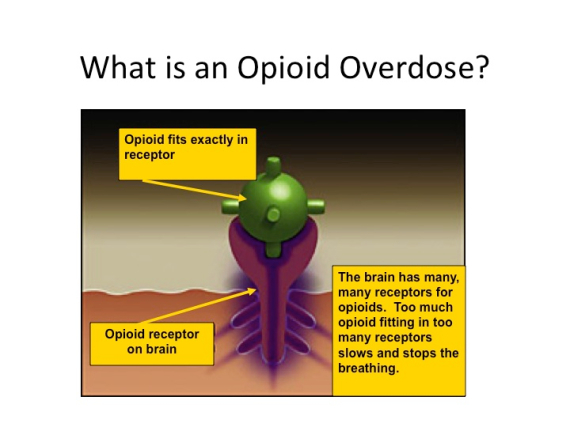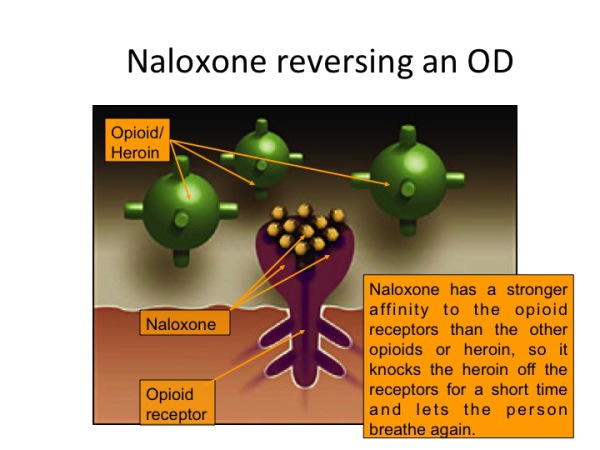Information on Opioid Overdose and How Naloxone Works
OPIOID OVERDOSE. There are different types of opiates/opioids that people use, and that children are exposed to in their homes. All of these are capable of leading to overdose and death. They include:
- Oxycodone (Oxycontin, Percodan, Percocet, Tylox)
- Hyodrocodone (Lortab, Vicodin, Hycodan, Lorcet, Vicoprofen, Hycet, Norco)
- Methadone
- Morphine
- Meperidine (Demerol)
- Codeine (Fioricet, tylenol #3)
- Oxymorphone (Opana)
- Fentanyl (Duragesic)
- Hydromorphone (Dilaudid)
- Buprenorphine (Suboxone, Subutex, Butrans)
- Counterfeit opioids (u-47700, pink)
- Heroin
Opioid overdose kills because it causes respiratory depression. This leads to:
- Slow or no breathing. This leads to blue color of skin (cyanosis) in lighter skinned individuals from very slow breathing. In darker skinned individuals, the color change is more greyish and ashen color. This progressses to the breathing stopping (apnea).
- Cardiac arrest as the heart stops because it is not getting oxygen.
- Circulatory collapse as circulation of blood to the brain stops.
An Opioid overdose is recognizable by the followings signs and symptoms (SMELL):
- Not SPEAKING - can't arouse them, they don't respond to painful stimuli
- Not MOVING - unresponsive
- EYES pinpoint pupils - pupils do not get bigger when the eyelid is opened (miosis)
- LIPS blue/gray, cold or clammy skin - not getting enough oxygen
- LUNGS respiratory depression - very slow or gurgling breathing, and ultimately no breathing
NALOXONE. Fortunately, opioid overdose is reversible through the timely administration of the drug naloxone (Narcan®) and the provision of emergency care.
- This is a very safe antidote and has been used in ambulances and hospitals for decades.
- It is stronger than the opioids it counters, so it will reverse the respiratory depression and REVERSE the overdose very effectively if administered in time.
- It is only effective against opioid overdoses.
- It is not against effective overdoses of other substances such as alcohol, cocaine, methamphetamine, or benzodiazepines.
- In some cases, more than one dose of naloxone is needed to reverse the effects of an opioid overdose.
- Unfortunately, its reversal effects last only 30-90 minutes. This requires that patients be observed after receiving naloxone because they are at risk of overdosing again from the potentially longer-acting substances still in their bodies when the naloxone wears off.
According to a recent CDC report (MMWR, Wheeler et al, 2015), as of 2014:
- There were 644 local opioid overdose prevention programs distributing naloxone to laypersons nationwide (a layperson in defined as a non-medical professional who may come into contact with a person overdosed on an opioid).
- From 1996-2014, these programs reported provding naloxone to 152,283 persons resulting in 26,463 overdose reversals and lives saved.
- Studies have found that providing naloxone kits does not lead to increased abuse or riskier use of opioids and can actually lead to increased enrollment in drug treatment.
Short Video on Naloxone for Opioid
Overdose Rescue




